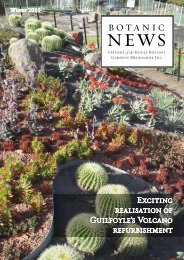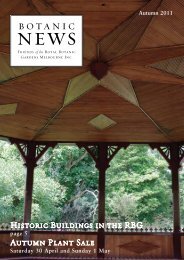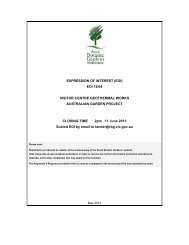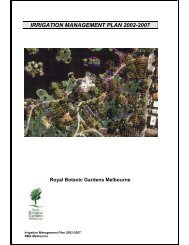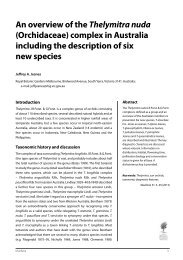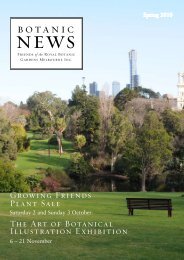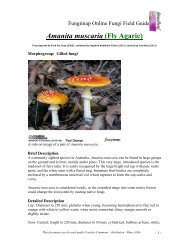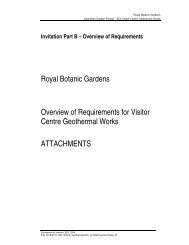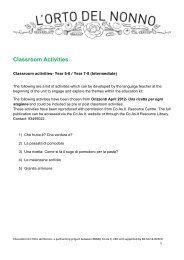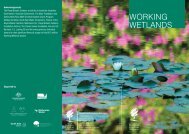Annual Report 2010-2011 (PDF - 2.47 mb) - Royal Botanic Gardens ...
Annual Report 2010-2011 (PDF - 2.47 mb) - Royal Botanic Gardens ...
Annual Report 2010-2011 (PDF - 2.47 mb) - Royal Botanic Gardens ...
You also want an ePaper? Increase the reach of your titles
YUMPU automatically turns print PDFs into web optimized ePapers that Google loves.
Contents<br />
Our Organisation<br />
RBG Melbourne extends over 38 hectares and houses a collection of over 10,000<br />
species of plants from around the world, including amazing and diverse plant collections<br />
such as camellias, rainforest flora, succulents and cacti, roses, Californian species,<br />
herbs, perennials, cycads, plants from Southern China and, in the recently-established<br />
Rare and Threatened Species Collection, plants from south-eastern Australia.<br />
Visitor nu<strong>mb</strong>ers<br />
Table 2: Visitor nu<strong>mb</strong>ers<br />
RBG Cranbourne<br />
General visitors 52,866<br />
Australian Garden visitors* 31,221<br />
84,087<br />
RBG Melbourne 1,542,399<br />
* Records adult and concession entry, children,<br />
City of Casey residents and students. Figures<br />
do not include guests, companions or <strong>Royal</strong><br />
<strong>Botanic</strong> <strong>Gardens</strong>’ RB<br />
Figure 1: RBG Melbourne<br />
& RBG Cranbourne<br />
1,800,000<br />
1,500,000<br />
1,200,000<br />
900,000<br />
600,000<br />
300,000<br />
0<br />
Melbourne<br />
1,619,695<br />
2009–10<br />
1,542,399 <strong>2010</strong>–11<br />
Cranbourne<br />
90,151<br />
2009–10<br />
84,087 <strong>2010</strong>–11<br />
Water management in the face of climate change presents a challenge to managing<br />
this heritage-listed site. The Working Wetlands project has continued with construction<br />
of Working Wetlands Part A and achievement of funding for Working Wetlands Part B<br />
from the Commonwealth Department of Sustainability, Environment, Water, Population<br />
and Communities. Ultimately, RBG Melbourne aims to achieve a sustainable irrigation<br />
water source that does not rely on the use of mains water.<br />
As one of Victoria’s most popular tourist attractions and just a short walk from the<br />
CBD, 1,542,399 visitors enjoyed RBG Melbourne in <strong>2010</strong>–11. Visitor services and<br />
facilities include guided walks, interpretive signs, a visitor centre, two cafés and a retail<br />
outlet – The <strong>Gardens</strong> Shop. The Ian Potter Foundation Children’s Garden remains<br />
popular with children and attracted an estimated 184,814 visitors, including over<br />
25,000 students, representing a 1.15 per cent increase over the previous year.<br />
The new Herbarium Discovery Walk was completed and opened in July <strong>2010</strong>, and<br />
has proved a popular interpretive display, explaining to visitors the working life of the<br />
Herbarium and providing insights into the scientific achievements and importance of<br />
this institution.<br />
National Herbarium of Victoria<br />
The National Herbarium of Victoria, founded in 1853 and located at RBG Melbourne,<br />
is the Victorian Government’s major centre for botanical studies in plant identification,<br />
collection and classification.<br />
The Herbarium houses the State <strong>Botanic</strong>al Collection, an irreplaceable resource of<br />
approximately 1.2 million dried specimens of plants, fungi and algae from Australia<br />
and many other countries. It is one of the most historically significant collections in<br />
the world and is used by Herbarium staff and visiting botanists for scientific research.<br />
Research areas include biodiversity, classification, evolution, biogeography, molecular<br />
systematics, conservation and horticulture.<br />
In addition, the State <strong>Botanic</strong>al Collection contains the oldest and most<br />
comprehensive botanical library in Australia. Current work at the Herbarium is directed<br />
by the Plant Sciences and Biodiversity Division Master Plan 2008–2012, which<br />
addresses three main research themes: Victoria’s biodiversity, including documenting<br />
and conserving our flora; the origin of the Australian biota, including the evolutionary<br />
history and relationship of Australian plant groups; and Biodiversity Services, including<br />
the provision of an Identification and Information Service.<br />
ARCUE<br />
ARCUE was created in 1998 to increase understanding of the ecology, restoration and<br />
management of biodiversity in urban and suburban areas throughout Australia and the world.<br />
ARCUE’s activities encompass basic and applied research; undergraduate, honours and<br />
postgraduate training; long-term ecological studies; community education; policy and<br />
management advice to all levels of government; and consultancy services. In addition, ARCUE<br />
works closely with the School of Botany at The University of Melbourne (where it is located),<br />
and with the research and education programs of RBG Melbourne and RBG Cranbourne.<br />
ARCUE continues to increase its environmental business activities in support of its<br />
research objectives.<br />
<strong>Royal</strong> <strong>Botanic</strong> <strong>Gardens</strong> Board Victoria <strong>Annual</strong> <strong>Report</strong> <strong>2010</strong>–11 page 9




